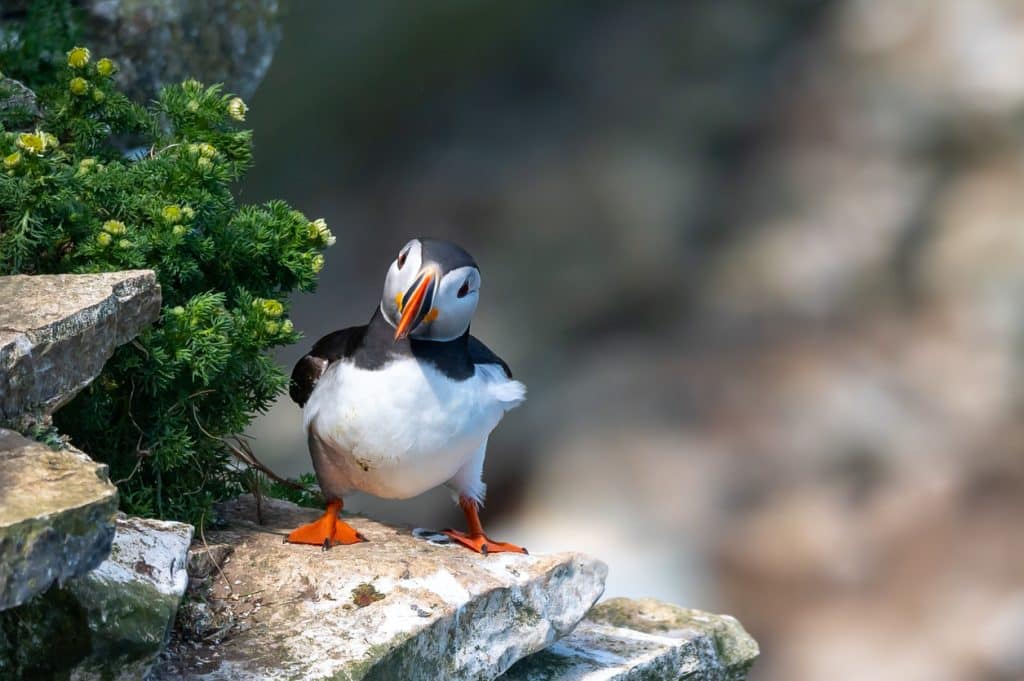Atlantic puffins, are often called “sea parrots” or even “clown of the sea” due to their penguin-like coloring, bright, colorful beaks and an affiliation with the water, where they spend most of their life. These beaks aren’t always so bold and saturated, however. The Atlantic puffin is usually sporting dull, gray beak in the winter, which only becomes colorful again during the mating season. This is an obvious tactic to attract a potential mate to procreate and help raise their young.
The Atlantic puffin is a stocky, medium-sized bird, somewhere between a robin and a crow in regard to size. This bird sports a solid, short neck, large head, and wide, colorful, triangular bill. It stands in an upright position on land and their beak will grow bigger, brighter and will acquire additional grooves as the bird ages. Atlantic puffins have relatively short, straight wings and will naturally fly with a quick and constant wingbeat.
Similar to most seabirds, Atlantic puffins have a standard lifespan of 30 years and often outlive that average. Due to their longevity, puffins take several years to fully sexually mature, usually mating between the ages of 3 and 6 years old. The Atlantic puffin is considered the official bird of Newfoundland and Labrador, Canada, with a large population often choosing to mate in that location.
Breeding rituals in Iceland
During the spring and summer seasons, Atlantic puffins will venture to the North Atlantic islands and coastlines to commence their breeding rituals, Iceland being the main breeding location for more than half of the population of Atlantics puffins, worldwide. The birds are especially drawn to rocky islands with little vegetation, closest to the sea. Since the Atlantic puffins spend more of their time out at sea, their period on land is short and limited. Regardless, the coastline is most comfortable for them, as they are accustomed to cold, wet conditions.
The birds will usually opt for steep cliffs to build their nests. They will then line their new home with soft feathers and tall grass. Female puffins only lay one egg and will share the responsibility of incubating it with her male partner. When the baby chick hatches, the parents will take turns bringing many small fish they caught in their bills, back to the nest.
The Atlantic Puffins share in the task of raising their young and, each and every year, the mates will reunite continuously at the same breeding site. It is not clear how the puffins find their way back to each other or their original breeding ground, but it is speculated that they use all of their senses. Certain visual points, sounds, and smells may be the key to navigating their way back home.
The Atlantic puffin’s diet consists of tiny fish, ranging between 2 to 6 inches in length. Their protein of choice contains mainly of sandlance, sprat, capelin, herring, hake, and cod.
Atlantic puffins will venture no further than 10 miles from the shoreline, remaining in shallow waters, opting to catch as many fish as possible in one expedition during the breeding season.
Their roomy beaks allow for optimal fishing, due to the backward-pointing spines that are located both on their tongue and the roof of their mouth, acting as a type of resistance to keep their catch of the day in place, until they return to their nest.
Atlantic Puffins nest in colonies on small islands
In order to begin constructing their nests for breeding season, the Atlantic puffin will dig a small, superficial hole with their spacious bill and wide feet. Just as they share the responsibility of feeding and raising their young, both male and female puffins will share the task of building their home.
The male will normally do more of the laborious work in comparison to the female. Once the space is cleared, the pair will gather feathers, long grass and sticks to line the bottom of their nest. It is fascinating to note that Atlantic puffins return to their nesting area and reuse their little home every year, when they come ashore to breed. During this season, they become more social, opting to hunt and forage in groups and choose to build their nests in close proximity to other couples. However, they are usually a less than social breed of bird, preferring to forage alone of with one other puffin.
Atlantic puffins spend most of the year in the sea, as their wings are much more efficient underwater. Due to their relevancy with the sea, puffins are naturally exceptional swimmers. The force of their strokes propels them forward and their broad feet are used as a type of controlling system to guide them while they swim. They only stay below the water’s surface for no more than 30 seconds. Their limbs are better suited for water, so they find it difficult to walk on land, resulting in a waddle that is similar to a penguin.
Atlantic puffins prefer to stay in shallow areas, to better fish and to stay safe in regard to predators, usually found in deeper waters. Upon their arrival to the colony, puffins with do a sort of bow, crouching horizontally, with one foot in front of the other, as a way to show respect and is also a way to request acceptance into the group. This is often taken as a signal of friendliness and peaceful coexistence.
Atlantics puffins are known to use certain body language to portray a variety of emotions and is an ideal form of communication. During mating season, puffins will often find a mate before coming onto the land from the sea. Once on land, the couple may perform an action called “billing”, a display where the two puffins will rub their beaks together, signifying their union and creating a deeper, closer bond.
An Atlantic puffin may use their walk as a way to communicate their feelings to their fellow colony members.
If the bird walks quickly and efficiently, with its head lowered, it is a way of signifying that it means no harm to the other birds and just wants to get to its destination. This is called a “low profile walk” and is non-threatening to other puffins, and they will usually not react to this behavior.
A male puffin typically guards its nesting burrow and will assume a “pelican walk,” which entails the puffin to stand rigidly upright with its bill beside its body and walk with slow, exaggerated steps. Like a soldier at full attention, the puffin is using this stance to ward off intruders and other males from their mate and offspring. Although not usually a violent gesture, the Atlantic puffin is ready for a fight if an intruder comes near their property.
A hostile confrontation between two puffins
A hostile confrontation between two puffins, usually male, often begins by gaping. The Atlantic puffin will inflate their body to give the illusion of a bigger size, thus intimidating their opponent. They will then spread their wings wide and begin to open their bill. The wider the gape, the more annoyed the puffin is. The bird may also proceed to stomp their feet, to better portray their displeasure. If a fight ensues, the Atlantic puffins will lock beaks and begin wrestling and flapping their wings wildly, in an attempt to throw each other to the floor.
Atlantic puffins are known to form lifelong, faithful relationships, almost mimicking monogamy. Male puffins will grunt and shake their head near a burrow, signaling to a female that he would like to mate. Once a match has been made, the birds will preserve their connection by stroking their bills against one another. Atlantic Puffins will often be seen shaking their heads or stomping their wideset feet to declare ownership of their nest. Male puffins that dare get too close to the burrow, may be attacked and fended off.
Puffins are surprisingly excellent flyers. They can flap their wings up to 400 times per minute and can achieve speeds of up to 55 miles an hour.
Nonbreeders at the colony have been seen performing “wheeling flight.” This is when a group of puffins fly around the nesting site in a figure-8 fashion, above the cliffs where the couples reside. Nonbreeding birds can be identified by their slight darker gray facial markings and a lack of yellow contrast on their beaks.
Are the Atlantic Puffins endangered?
Atlantic Puffins, thankfully, are not yet considered endangered, as their numbers remain in the millions. However, puffin populations are slowly beginning to dwindle, as their food supplies change, due to warm water climates, affecting the availability of Sandlance, a popular meal choice for puffins. This interferes significantly with their breeding process. In North America, Atlantic puffins currently rate 8 out of 20 on the “Continental Concern Score,” meaning they are not yet on the “Partners in Flight Watch List” and are not as nationally protected, with no additional conservation attempts made.
It is estimated that their numbers dwell somewhere in the 12 million mark and is ranked as “Vulnerable” on the “IUCN Red List.” Most of today’s puffin population will breed on small, offshore islands of Iceland, when, in the past, this bird used to breed right on Iceland’s mainland. Atlantic puffins were entirely wiped out from America in the early 1900s, due to hunting for their meat and feathers, as well as overharvesting their eggs.
Although Atlantic puffins are not yet considered an endangered species, they are constantly being threatened by human activities, such as overfishing, resulting in starving chicks, overhunting for the use of their meat and feathers and oil spills, that will affect not only their natural habitat, but also their overall health. Oil will ruin the waterproofing effect of a puffin’s feathers, causing the bird to die from exposure to cold temperatures. Atlantic puffins are now rare in regions where they were once plentiful.
As a result, it is essential to protect the Atlantic puffin from entering the endangered species list by protecting their habitat from outside forces and human interference. These birds are a beautiful, intelligent and nonthreatening species that deserve, just like any other creature, a safe and bountiful life on the planet we call home.

